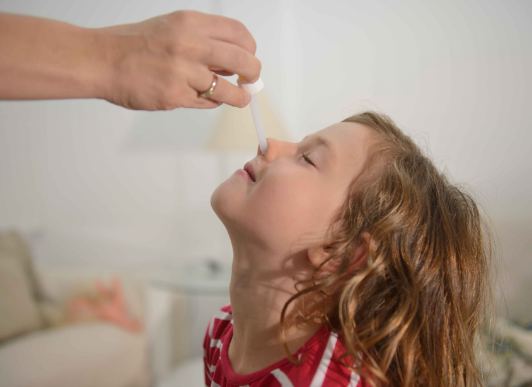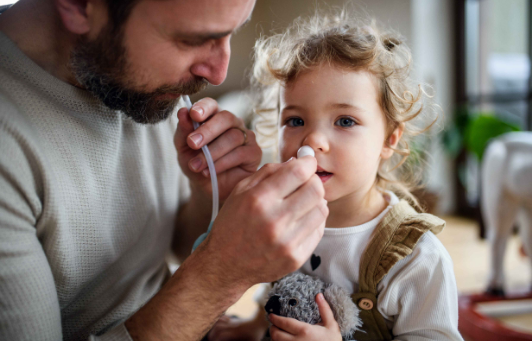Pediatric ENT Disorders
Nasal and Sinus Disorders
The nasal and sinus system is made up of the nose, the sinuses, and the throat. The nose has three parts: the nostrils, the septum, and the turbinates. The septum divides your nose into two separate channels. Each channel allows air to flow through one side and out through another. The turbinates are located within each channel to provide a moist environment for air to come into contact with your mucous membranes.
- Nosebleeds
- Environmental Allergies
- Nasal Obstruction
- Sinusitis
Nosebleeds
Nosebleeds are common in children, especially during the winter when dry air can irritate the lining of the nose. Irritation can cause small blood vessels in your child’s nose to break, which results in a nosebleed. Several causes of minor irritation can lead to nosebleeds, including dry air and mouth breathing. The outer part of your child’s nose may become irritated if they have a stuffy or runny nose. Most nosebleeds are not serious and will stop on their own.
If nosebleeds are too frequent or don’t stop quickly, there may be an underlying issue. When doctors diagnose a more serious cause for frequent nosebleeds, they will look for the best treatment method, which may include surgery.

Nasal and sinus disorder is when the nose or sinuses do not work properly due to colds, allergies, infections (e.g., sinusitis), or structural problems (e.g., deviated septum). Pediatric ENT specialists can help children and adolescents cope with these conditions by performing diagnostic tests
When you see a pediatric ENT specialist, they will ask questions about your child’s symptoms and do an exam, such as using a lighted instrument called an endoscope to look inside your child’s nose and sinuses. This is similar to an endoscope used in an adult doctor’s office. If these tests show a problem with your child’s nasal and sinus system, pediatric ENT specialists can perform additional testing and determine the best treatment plan for your child. In some cases, doctors may need to remove part of the obstruction from your child’s nose or sinuses during surgery.
Environmental Allergies
Allergens can be found everywhere, and they are especially common in the home. Dust mites, pet dander, mold, and other insects can set off an allergic reaction for someone with asthma or seasonal allergies. With so many allergens in our homes, it is important to keep your family’s environment as clean as possible to limit exposure to allergens.
Environmental allergies can be treated using air filters, high-efficiency particulate air (HEPA) filters, room humidifiers, and dehumidifiers. Keep your windows closed during seasons when pollen counts are high, and always try to open them on days when pollen counts are low.

Nasal and sinus disorder is when the nose or sinuses do not work properly due to colds, allergies, infections (e.g., sinusitis), or structural problems (e.g., deviated septum). Pediatric ENT specialists can help children and adolescents cope with these conditions by performing diagnostic tests
When you see a pediatric ENT specialist, they will ask questions about your child’s symptoms and do an exam, such as using a lighted instrument called an endoscope to look inside your child’s nose and sinuses. This is similar to an endoscope used in an adult doctor’s office. If these tests show a problem with your child’s nasal and sinus system, pediatric ENT specialists can perform additional testing and determine the best treatment plan for your child. In some cases, doctors may need to remove part of the obstruction from your child’s nose or sinuses during surgery.
Nasal Obstruction
Nasal obstruction is one of the most common issues that pediatric ENT specialists treat. Nasal obstruction can lead to difficulty breathing, snoring, sleep apnea, and chronic headaches. Other symptoms include nasal discharge, crusting in the nose or mouth, sinus pain, stuffiness, and frequent colds. Pediatricians often refer patients with these symptoms to a pediatric otolaryngologist for evaluation and treatment options.
The most common causes of nasal obstruction include sinusitis, allergic rhinitis, and post-nasal drip. A pediatric otolaryngologist can identify the obstruction and remove it safely and effectively so your child can breathe more easily and sleep better at night. Pediatric ENTs see a lot of children with forms of congenital anomalies.

Nasal and sinus disorder is when the nose or sinuses do not work properly due to colds, allergies, infections (e.g., sinusitis), or structural problems (e.g., deviated septum). Pediatric ENT specialists can help children and adolescents cope with these conditions by performing diagnostic tests
When you see a pediatric ENT specialist, they will ask questions about your child’s symptoms and do an exam, such as using a lighted instrument called an endoscope to look inside your child’s nose and sinuses. This is similar to an endoscope used in an adult doctor’s office. If these tests show a problem with your child’s nasal and sinus system, pediatric ENT specialists can perform additional testing and determine the best treatment plan for your child. In some cases, doctors may need to remove part of the obstruction from your child’s nose or sinuses during surgery.
Sinusitis

Nasal and sinus disorder is when the nose or sinuses do not work properly due to colds, allergies, infections (e.g., sinusitis), or structural problems (e.g., deviated septum). Pediatric ENT specialists can help children and adolescents cope with these conditions by performing diagnostic tests
When you see a pediatric ENT specialist, they will ask questions about your child’s symptoms and do an exam, such as using a lighted instrument called an endoscope to look inside your child’s nose and sinuses. This is similar to an endoscope used in an adult doctor’s office. If these tests show a problem with your child’s nasal and sinus system, pediatric ENT specialists can perform additional testing and determine the best treatment plan for your child. In some cases, doctors may need to remove part of the obstruction from your child’s nose or sinuses during surgery.

